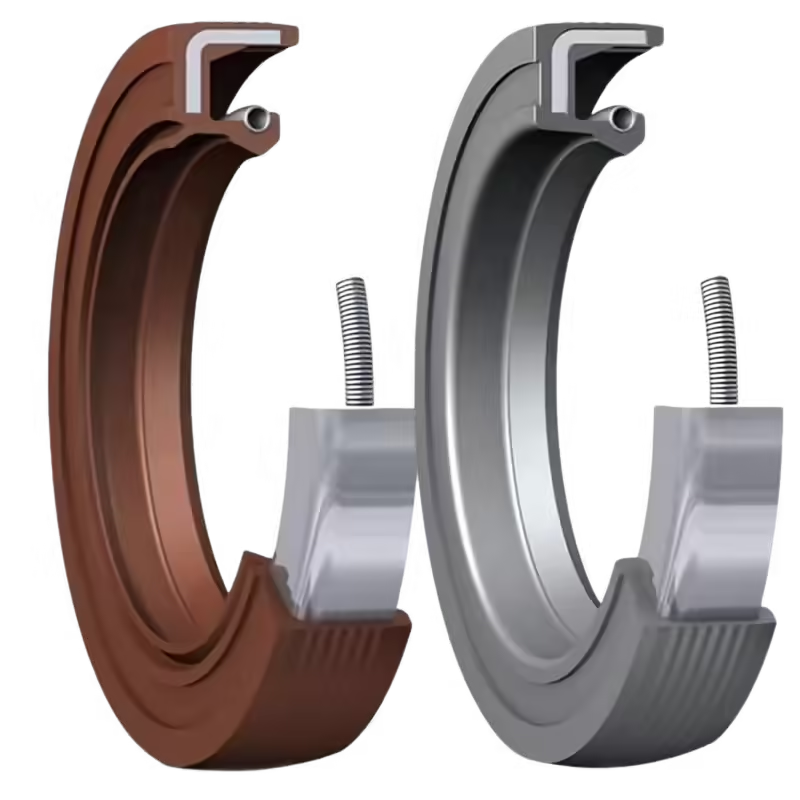Are you unsure how to select the best rotary shaft seal for your high-temperature equipment? This guide will walk you through rotary shaft seal types, materials, and critical selection considerations.
Imagine Mr. Li’s high‑viscosity chemical mixer in California grinding to a halt mid‑batch because a low‑cost rotary shaft seal let solvent leak and abrasive particles invade the gearbox. That coin‑sized component halted the entire production line, forcing a full batch to be scrapped and costing thousands in downtime and clean‑up.
Small seals, big consequences. This guide will help you pick the right rotary shaft seal so that scenarios like Mr. Li’s stay hypothetical.
1. Introduction to Rotary Shaft Seals
1.1 Why Rotary Shaft Seals Matter
- Prevent Leakage: Keep lubricants and other fluids contained, thus avoiding equipment damage and environmental pollution.
- Block Contaminants: Prevent the ingress of dust, moisture, and other debris into critical components like bearings.
- Extend Equipment Lifespan: Reduce wear and tear, ensuring smooth and reliable operation with minimal downtime.
1.2 Core Components of Rotary Shaft Seals
- Sealing Lip: The primary contact point forming the seal on the shaft surface.
- Elastomeric Material: Allows the seal to flex and compensate for slight shaft movement or vibration.
- Metal Casing: Provides structural support and rigidity.
- Spring (Optional): Ensures constant pressure for a secure seal around the shaft.
2. Types of Rotary Shaft Seals
2.1 Single Lip Seals
- Features: A single sealing lip for basic leak prevention.
- Ideal For: Environments with low contamination, such as automotive water pumps or light-duty machinery.
- Advantages: Cost-effective and straightforward; suitable for standard temperature and medium-speed applications.
2.2 Double Lip Seals
- Features: Adds a dust lip to the main sealing lip for enhanced dirt protection.
- Ideal For: Harsh or dirty conditions like off-road vehicle axles, construction equipment, and mining machinery.
- Advantages: Excellent dust and debris protection, reducing overall maintenance costs.
2.3 PTFE Seals (Teflon Seals)
- Features: High heat and chemical resistance with a low coefficient of friction.
- Ideal For: Aggressive chemicals or extreme heat, such as chemical pumps handling acidic media, aerospace, and pharmaceutical equipment.
- Advantages: Exceptional longevity under harsh conditions, maintaining sealing performance at elevated temperatures.
2.4 Spring-Loaded Seals
- Features: An internal spring ensures consistent lip pressure.
- Ideal For: High-speed applications, such as turbine shafts or compressors running at speeds of 10,000 RPM or higher.
- Advantages: Stable sealing performance even under dynamic or slightly misaligned shaft conditions.
2.5 Split Seals
- Features: Split design allows installation without dismantling large equipment.
- Ideal For: Massive industrial gearboxes, pumps, or rotating systems where downtime needs to be minimized.
- Advantages: Faster maintenance and reduced labor costs since the shaft and housing do not require full disassembly.
2.6 Specialized Seals
- Stainless Steel Reinforced PTFE: Excellent wear resistance for corrosive fluids (e.g., offshore oil platforms).
- Super Dustproof DC Seals: Block fine particles in mining or tunneling operations.
- Anti-Vibration External Skeleton Seals: Remain secured in heavy-vibration setups like cranes or heavy-duty machinery.
- High-Pressure Seals: Engineered to handle extreme pressures found in hydraulic presses and high-pressure pumps.
Looking to Purchase the Right Oil Seal?
If you want to explore and buy the ideal oil seal for your application, follow this link:
https://drorubber.com/oil-seals/
3. Materials Used in Rotary Shaft Seals
3.1 Elastomers
NBR (Nitrile Rubber)
- Strengths: Resistant to most mineral oils and greases, suitable for temperatures up to ~100°C, and speeds up to 1,300 RPM.
- Limitations: Not ideal for high temperatures or aggressive chemicals.
- Applications: Automotive engine oil seals, general industrial equipment.
FKM (Fluorocarbon Rubber)
- Strengths: Excellent chemical resistance and can withstand temperatures up to 200°C, normal speeds up to ~4,000 RPM (advanced FKM up to 30,000 RPM).
- Applications: Aircraft engines, high-temperature pumps, and chemical processing equipment.
EPDM
- Strengths: Great for water and steam applications due to good thermal stability and flexibility.
- Applications: Seals in steam systems, boilers, and hot water pumps.
3.2 Advanced Materials
PTFE (Polytetrafluoroethylene)
- Strengths: Superb chemical inertness, high temperature tolerance, and long service life.
- Example Use: Pharmaceutical reactors handling corrosive substances.
Ceramics/Carbon
- Strengths: Extremely high wear resistance and stability at elevated speeds.
- Example Use: High-speed aerospace bearings or precision CNC machine spindles.
4. Key Applications for Rotary Shaft Seals
- Automotive: Engine crankshafts, transmissions, wheel hubs for leak-free performance.
- Industrial Equipment: Gearboxes, pumps, and compressors that demand reliability in manufacturing settings.
- Aerospace: Turbine engines, landing gear, or other high-stress components operating in extreme environments.
- Heavy Machinery: Excavators, tractors, and other off-road vehicles exposed to dust, vibration, and pressure fluctuations.
- Marine/Offshore: Propeller shafts, subsea pumps, and equipment requiring corrosion and saltwater resistance.
5. Performance Factors and Challenges
5.1 Temperature
- Impact: Excessive heat accelerates elastomer aging, while very low temperatures can cause material stiffening.
- Recommendation: Use FKM or PTFE when operating above 150°C to avoid premature seal failure.
5.2 Shaft Speed
- Impact: High speeds elevate friction and temperature; spring-loaded designs help maintain a stable seal.
- Recommendation: Consider FKM or PTFE for applications exceeding 4,000 RPM.
5.3 Pressure
- Impact: High pressure can deform or extrude the seal if not properly reinforced.
- Recommendation: For systems above 500 PSI, opt for heavy-duty, metal-cased, or high-pressure-specific seals.
5.4 Fluid Compatibility
- Impact: Materials must match the fluid’s chemical properties to prevent swelling, cracking, or degradation.
- Recommendation: Select PTFE for highly corrosive chemicals; NBR for standard oils.
5.5 Contamination
- Impact: Dust, dirt, and moisture can accelerate lip wear and reduce seal effectiveness.
- Recommendation: Choose dual-lip or specialized dustproof seals for harsh outdoor or industrial environments.
6. How to Select the Right Rotary Shaft Seal
Match Material to Fluid and Temperature
- FKM or PTFE for high-temperature or corrosive media.
- NBR for typical lubricating oils below 100°C.
Accurate Dimensions
- Ensure tight tolerances for the shaft outer diameter, seal inner diameter, and housing. A tolerance under 0.05mm is often recommended.
Assess Operating Environment
- Is the shaft speed over 4,000 RPM? Is system pressure above 500 PSI?
- Determine if you need spring-loaded, dual-lip, or heavy-duty reinforced seals.
Service Life and Maintenance
- Shaft surface finishing (e.g., Ra <0.8μm) and correct installation can substantially lengthen the seal’s lifespan.
- Regular inspections help prevent unexpected seal failure.
7. Innovations and Trends
- Advanced PTFE Compounds: Providing even greater wear resistance under higher temperatures and speeds.
- Smart Seals: Built-in sensors track wear and temperature in real time, enabling predictive maintenance.
- Eco-Friendly Materials: Biodegradable elastomers for more sustainable machinery solutions.
8. Conclusion
Rotary shaft seals play a pivotal role in keeping machines running smoothly—whether in automotive, aerospace, heavy machinery, or marine applications. Understanding their types, materials, and the factors influencing performance is key to selecting the most suitable seal to prevent leaks and minimize downtime. For high-quality, customized solutions, visit
Drorubber Official Website
or contact us via WhatsApp (+0086 15815831911) or WeChat (+0086 13784044874).





